Green Architecture for the Future, Photos, Architect, Info, Danish Design, Dates
Green Architecture for the Future : Louisiana Museum
Louisiana Art Gallery : Building Exhibition, Denmark
page updated 2 Sep 2016
Louisiana Art Gallery Exhibition
The exhibition Green Architecture for the Future elucidates the relationship between architecture and society and the vast field mapped out by discussions of sustainability, with its whole range of challenges. The aim of the exhibition is to present the vitality with which many architects are grappling with the current situation.
The exhibition gives words, walls and spaces to architects and architectural philosophers who try to view the architectural projects of the future as living machines, cities as new and different structures, and buildings as ‘intelligent’, so that they are not only self-sufficient but also make a positive contribution to their surroundings, create biological diversity and produce cleaner air.
The exhibition presents samples, performing a kind of thematic and temporal acupuncture in the complex field represented by aspects of the sustainability concept that are constantly shifting the frontiers of architecture.
We sample some of the architectural laboratories of the future to present the latest ideas in the field.
Green Architecture for the Future
29 May – 4 Oct 2009
Exhibition curator : Kjeld Kjeldsen
Museum director : Poul Erik Tøjner
We include images / links to featured buildings + designs
A new attitude to the environment is growing up at present, with demands for sustainable future development in the world. It is leaving its mark on many architects’ ideas, working methods and projects where brand new visions of the future are on the agenda.
These ideas are prompting architects, scientists, philosophers, engineers and chemists to join forces in the development of new and different construction materials, alternative structures and revolutionary solutions to the many challenges that arise when sustainable cities, landscapes and environments are to be established. Globally, what we are seeing is something like a paradigm shift – that is, a new world-picture that is emerging, starting in the 21st century.
Louisiana‘s exhibition Green Architecture for the Future takes the pulse of a process of change that is in full swing, and the exhibition shows some of the complex initiatives and future scenarios that are mushrooming up on the global scale.
Watercube Beijing
2006
PTW Architects
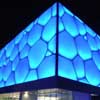
photograph : PTW
Sustainable development is traditionally divided up into three different ‘pillars’: economic, environmental and social sustainability. With these three parameters in mind, the task is to conceive of solutions for a world that meets mankind’s needs for technology, comfort and growth right now, without at the same time depriving future generations of the fulfilment of their similar needs. It is the ambition of the exhibition to perform a kind of thematic and chronological acupuncture in the flow of visions and specific measures that is constantly shifting the frontiers of architecture.
Eco-boulevard Madrid
2008
Ecosistema Urbano
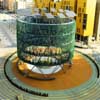
photo : Ecosistema Urbano
Green Architecture for the Future : The Exhibition
The exhibition is a thematic crossover exhibition to be shown in the Graphics Wing in the lowest part of the museum. It is divided into three sections which are in turn reflected outdoors in the Louisiana Sculpture Park by three structures that physically and tangibly underscore some of the themes of the exhibition.
The focus here is on new, sustainable, intelligent materials and technologies in the areas of solar energy as well as recyclable materials. In addition each theme is clarified in four experimental laboratories of the future that pinpoint the concept of sustainability in a discursive, thought-provoking way.
T. R. Hamzan & Yeang Sdn. Bhd.
Llewelyn Davies Yeang, U.K.
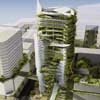
A wide range of architects have been invited to exemplify the themes of the exhibition (see the list below). The four laboratories have been developed by the Spanish architect team from Madrid, Ecosistema Urbano (social sustainability), the British Foster+Partners (the new CO2-neutral Masdar City in the United Arab Edmirates), the French architect also based in Lausanne Switzerland, Philippe Rahm (physiological and meteorological architecture) and the French Paris based R&Sie(n) (the lifetime of buildings and the perishability of materials).
Hilsen til solen / Greeting to the sun
Nikola Basic, Zadar
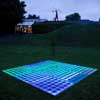
photo: Hans Ole Madsen
Themes and laboratories
The exhibition is built up around the following three themes: THE CITY, CLIMATE & COMFORT and METABOLISM.
THE CITY is the first theme of the exhibition. The massive population drift to the cities everywhere in the world makes the urban situation the most important focus for sustainable development. The greatest challenges lie here too: population growth, population density and infrastructure; how is the future of the existing city conceived, and how will the brand new sustainable cities of the future look?
The point of departure for the theme and the first laboratory is the Spanish architectural team Ecosistema Urbano, which works to rethink the city at several levels. The two architects themselves, Belinda Tato and José Luis Valléjo, say that they work with so-called urban acupuncture in both the existing city and in new urban neighbourhoods that require social, communicative and aesthetic upgrading.
SIEEB; Beijing, China
2006
Mario Cucinella Architects, Bologna
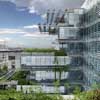
photo : Daniele Domenicali
As a contrast to this, a proposal for the new city is unfolded in the second laboratory for this theme, created by Foster+Partners. It follows the planning of Masdar City in the United Arab Emirates, the first CO2-neutral city in the world. Inspiration from Arab culture and building customs is combined with wind towers and solar cells to supply energy and ventilation for natural cooling of the desert city.
In the city section, the public is also introduced to a number of other projects in the world. These include the French president Nicolas Sarkozy’s initiative ‘Rethink Paris’ – the re-establishment of Paris as a cohesive city, conceived by ten specially selected architects; the exploitation of the positive aspects of the favela slum areas in South America through recycling and improvements of the existing houses and the model city Curitiba in Brazil, where the mayor of the town, the architect Jaime Lerner, has implemented consistent waste sorting and mass transport networks.
The section also deals with the green element in the city: from the ‘vertical garden’ to sustainable and ‘green’ skyscrapers.
Tower of Tomorrow – Project, Frankfurt am Main, Germany
2007
William McDonough + Partners
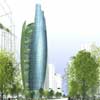
CLIMATE & COMFORT is the next theme in the exhibition. This section explores new principles for energy-saving and energy-producing architecture, the use of solar cells, wind towers and water power, new kinds of heating and ventilation and climatic potential for comfort – as well as examples of the aesthetic generated by new materials and construction types.
The German engineers Transsolar work with several major international architects on sustainable, architectural solutions, and these projects form the backbone of this section. Alongside this a more historical layer offers insight into earlier building customs from different regions – and shows how the architects of today have learned from indigenous construction culture with their point of departure in the site-specific local climate.
In the laboratory for this theme the French architect Philippe Rahm relates to meteorology and thermic systems and we see how it is possible to integrate such systems as an architectural principle in the formation and utilization of space.
The United Bottle Project
2007
INSTANT Architects
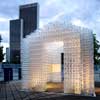
photo : Dirk Hebel, Jörg Stollmann and Tobias Klauser
METABOLISM is the third and last theme of the exhibition. It shows how the lessons learned from nature’s ecosystem and cycles can be integrated in architecture and used as design parameters and principles. The theme involves several aspects of the cyclic idea: the recycling of materials, the development of new ‘intelligent’ materials; re-use in the form of renovation of existing buildings that are gradually made sustainable; and consideration of the future lifetime of brand new projects.
One theoretical approach is the ‘Cradle to Cradle’ principle conceived by the architect William McDonough and the chemist Michael Braungart. Together they have developed ways of showing consideration for the environment, rethinking production and recycling methods, and improving them by ensuring a technical as well as a biological cycle based on the lessons of nature.
This theme’s laboratory architects – the fourth and last laboratory in the exhibition, R&Sie(n) – work with energy systems that involve everything from biological processes to human relations with the built-up landscape and magnetic energy. The specific conditions of each place are turned into potentials and function as design principles.
The architects apply the inherent energy of their architectural programmes to the specificity of places, and use these parameters to generate their architectural idiom. The underlying factors here are reflections on the ecosystems of buildings and materials, their lifetime and perishability.
The United Bottle Project
2007
INSTANT Architects
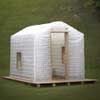
photo: Hans Ole Madsen
Structures in the Louisiana Sculpture Park
As mentioned above, the three themes of the exhibition engage in a dialogue with outdoor structures set up in the Louisiana Sculpture Park. These turn the focus on new, sustainable materials and technologies using solar cells, recyclable materials and new so-called intelligent materials. In the constructions, for example, the public will have the opportunity to experience some of the themes of the exhibition in physical form.
Laboratorium 3: Philippe Rahm
Green Architecture for the Future : The Exhibition
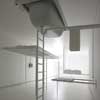
photo : Brøndum & Co
Catalogue and Louisiana Magasin no. 30
In connection with the exhibition, Louisiana is publishing a special catalogue with a preface by the director of the museum, Poul Erik Tøjner, interviews by the architect Peter Andreas Sattrup PhD with Ecosistema Urbano, Foster+Partners, Philippe Rahm and R&Sie(n) and the articles “Nature is silent” by Professor Ole Thyssen, dr. phil., CBS, “Time for a paradigm shift: the ecological challenge to architecture” by the architect Professor Wilfried Wang, Berlin, and “The Materials of the Future” by the architect and head of development at the architectural office 3xN, Kasper Guldager Jørgensen. The book, with 144 richly illustrated pages, also includes descriptions of about 50 different projects in the field.
Buegang: Klima-afsnit
Green Architecture for the Future : The Exhibition
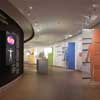
photo : Brøndum & Co
Louisiana Magasin no. 30 (only in Danish) features the article “The Cherry Tree Rules” by the exhibition’s co-curator Mette Marie Kallehauge, dealing with the concept “Cradle to Cradle”, which is also the title of a new book that will now appear in Danish. “Cradle to cradle” is a concept that tries to integrate existing knowledge of sustainability. The co-author of the book, Michael Braungart, will be at Louisiana on the opening day. Ole Thyssen’s article from the catalogue will also be in Louisiana Magasin.
Store Sal: By-afsnit
Green Architecture for the Future : The Exhibition
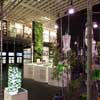
photo : Brøndum & Co
The exhibition series The Frontiers of Architecture I-IV
Louisiana’s exhibition series The Frontiers of Architecture I-IV, which is being shown in the years up to 2011, sheds light on new and alternative architectural movements today, and the paths pointing towards what we regard as the frontiers of architecture. The first exhibition in the series was Cecil Balmond: Unfolding New Dimensions (2007).
This was an exploration of the relationship between science and architectural design, with the engineer Cecil Balmond as an example of the new reflections and investigations that underlie the architecture of today and – not least – of the future. Green Architecture for the Future is the second exhibition in the series.
The Green Architecture for the Future exhibition has been made possible by support from Realdania, sponsor of architectural exhibitions at Louisiana.
DONG Energy. Sponsor for Louisiana Museum of Modern Art 2009
Nykredit. Sponsor of Louisiana Contemporary
The C. L. David Foundation supports Louisiana Live
Politiken. Media sponsor for Louisiana
Laboratorium 1: Ecosistema Urbano
Green Architecture for the Future : The Exhibition
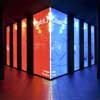
photo : Brøndum & Co
Green Architecture for the Future : Participating architects / studios
3XN, Copenhagen, Danmark
Alsop Architects, London, England
Behnisch Architekten, Stuttgart, Germany
COBE, Copenhagen, Danmark
Michael Braungart & William McDonough – Cradle to Cradle
William McDonough + Partners, Charlottesville, Virginia, USA
Ecosistema Urbano, Madrid, Spain (LAB)
ENTASIS, Copenhagen, Danmark
Foster + Partners, London, England (LAB)
Frederic Druot, Paris, France
GrAT, Vienna, Austria
Jaime Lerner, Curitiba, Brazil
Ken Yeang, Penang, Malaysia
Lacaton & Vassal, Paris, France
Mario Cucinella Architects, Bologna, Italy
Meti School Project, Anna Heringer (Salzburg, Austria) & Eike Roswag (Berlin, Germany)
Mette Lange, Faksinge, Denmark
Michel Desvigne, Paris, France
MVRDV, Rotterdam, The Netherlands
Nikola Basic, Zadar, Croatia
Patrick Blanc, Paris, France
Philipp Oswalt, Berlin, Germany
Philippe Rahm, Paris, France & Lausanne, Switzerland (LAB)
PTW Architects, Sydney, Australia
R+Sie(n), Paris, France (LAB)
Richard Rogers, London, England
Roland Castro & Sophie Denissof, Paris, France
Sarah Wigglesworth, London, England
Sauerbruch Hutton, Berlin, Germany
Shigeru Ban, Tokyo, Japan
Stefano Boeri Studio, Milan, Italy
Studio Monte Rosa, Prof. Andrea Deplazes, ETH, Zürich, Switzerland
Transsolar (Matthias Schuler) – Engineering firm, Stuttgart, Germany
United_Bottle Group UBG (formerly: Instant_Architects), Zürich, Switzerland
Copijn, Utrecht, The Netherlands – landscape architects
Artists:
An Te Liu, Toronto, Canada
Ton Matton, Wendorf, Germany
Louisiana Art Gallery Building, Humelbaek, northeast Sealand, Denmark
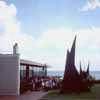
photo © Adrian Welch
Louisiana Museum of Modern Art
Learning from Nature, Louisiana Museum of Modern Art
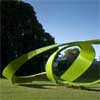
photo : 3XN / Adam Mørk
Green Architecture for the Future Sculpture
Location: Copenhagen, Denmark
Architecture in Copenhagen
Copenhagen Architecture Designs – chronological list
Comments / photos for the Green Architecture for the Future at Louisiana Art Gallery page welcome
Website: www.louisiana.dk
